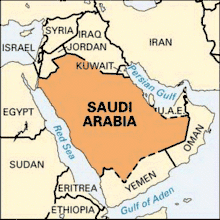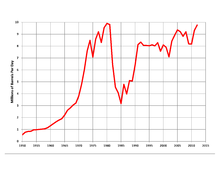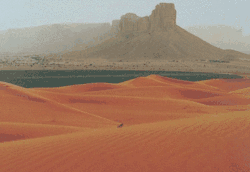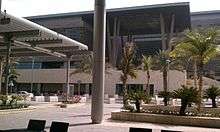Environment of Saudi Arabia
The desert-covered Kingdom of Saudi Arabia is the geographically largest country in the Middle East.[1] Moreover, it accounts for 65% of the overall population of the GCC countries and 42% of its GDP[2]. Saudi Arabia does not have a strong history in environmentalism. Thus, as the number of population increases and the industrial activity grows, environmental issues pose a real challenge to the country[3]. Lack of environmental policy can be linked to an enormous reliance on oil. Due to intense fossil fuel usage, Saudi Arabia has generated a number of environmental issues. Urbanization and high standards of living contribute to ground, water, and air pollution. Agriculture and overconsumption of natural resources cause deforestation and desertification. Likewise, Saudi Arabia’s oil industry subsidizes energy use and magnifies carbon dioxide emissions. These environmental issues cause a variety of health problems including asthma and cancer. Some environmental action is taking place such as the construction of a renewable energy industry. Policies and programs are also being developed to ensure environmental sustainability.
Background

Saudi Arabia contains the largest known oil reserve. This generates an abundance of wealth for the country and places it as the number one oil exporter in the world.[1] Oil extraction is a priority over environmental policy. While oil is not environmentally sustainable, Saudi Arabia has made some contributions to fighting climate change. The kingdom implemented its first environmental law in 1992, the Presidency of Meteorology and Environmental Protection Act.[4] This measure was enacted to encourage environmental awareness and sustainable law creation. Moreover, Saudi Arabia and other Arab nations are working together to create a series of international environmental contracts. Saudi Arabia alone has signed eighteen pacts and ratified thirty-nine environmental agreements.[5] Saudi Arabia's environmental performance index (EPI) is 55.3. The EPI is an internationally standardized scale, with 1 as the lowest environmental performance and 100 as the highest. The scale measures both environmental health and ecosystem viability.[5] Out of Middle Eastern countries, Saudi Arabia ranks 9th on the EPI.
Environmental challenges
Pollution
Oil pollution

As the largest oil exporter in OPEC, Saudi Arabia contributes to the immense environmental impacts associated with oil drilling.[6] This includes hydraulic fracturing, oil spills, and air pollution. Saudi Arabia contributed to the world's most severe spill, the 1991 Gulf War Oil Spill. The environmental impacts from oil spills are long lasting and often irreversible. The Gulf War spill directly affected the Saudi Arabian shoreline.[7] While initial research found minuscule long-term impacts, recent studies show oil persistence in ocean habitats.[7] Oil persistence affects ecosystem relationships and the livelihood of all marine animals. The Gulf Coast spill increased the toxicity of Saudi Arabia's coastline. During the initial aftermath, only visible oil was removed from the Gulf. The rest of the spill has remained in the ocean for the past 25 years and contributes to high-risk amounts of hydrocarbons in the environment.[7] Saudi Arabia's salt marshes have had a hard time recovering from past spills. Thick oil coverage permanently changed the biodiversity and chemical compositions of many ocean related habitats. This environmental damage will take decades to reverse.
An abundance of oil resources promotes wasteful energy practices throughout Saudi Arabia. The government encourages energy use through subsidies.[8] Currently, these subsidies are higher than any other regime at a total of 43 billon US dollars a year.[8] Inexpensive energy supports excessive energy use, contributing to high rates of domestic oil consumption. The hot, arid climate of the Middle East causes widespread use of air conditioning for climate control.[9] Power consumption and carbon dioxide emissions increase each year.
Urban pollution
Urbanization causes ground, water, and air pollution. Increasingly urban areas call for more desalinated water and a growing water sector. Desalinization plants use greenhouse gasses and are highly inefficient.[8] The process of oil extraction also contributes to air pollution by emitting high rates of carbon dioxide. Excess greenhouse gas emissions deplete the ozone and raise global temperatures.
Marine life and ocean ecosystems are threatened by urbanization as well. Coastline construction from residential and tourism projects increase the amount of untreated sewage released into the ocean and excess trash in cities.[8] Construction and human activities lead to coastal reef damage and high ocean acidity.[8] Urban and agricultural runoff frequently contaminate waters by releasing untreated waste.
Ground pollution results from both oil drilling and urbanization. The city of Jeddah and other urban areas face problems of heavy traffic that leads to roadside contamination and high carbon emissions.[10] Saudi Arabia's high standard of living encourages fossil fuel based transportation.[1] Saudi Arabia has yet to develop a concrete public transport sector.[8] Therefore, private transportation is a major contributor to air pollution. Moreover, car usage and city life contribute to dangerous degrees of heavy metals in urban soils.[10] These metals are harmful for both humans and plants, as soil contamination inhibits plant growth and are poisonous when ingested.[10]
Deforestation and desertification
Urbanization, expansion of agriculture, and energy consumption contribute to deforestation. Wood is the primary natural resource used in local communities. Studies show that wood is often used inefficiently by people living in rural, traditional housing.[11] Saudi Arabia's growing population increases food insecurity. In turn, forests are cleared at higher rates to make more area for agriculture. Deforestation occurs both legally and illegally. Research on woodland conservation shows that there are few initiatives taking place to slow deforestation.[11]

Increasing global temperatures are projected to accelerate desertification within Saudi Arabia.[1] Desertification will have a variety of impacts on the country's population. Desertification limits residential expansion and prevents small scale farmers from gaining access to lands. The growing industrial agriculture sector contributes to desertification. Mass monoculture disrupts soil processes and depletes the fertile soils on nutrients. The expansion of industrial agriculture misuses the scarce water resources available to Saudi Arabian farmers.[12] This practice depletes naturally fertile land of water, leading to desertification as well.
Environmental action
Renewable energy
Currently, there are no programs encouraging reduced fossil fuel use.[13] Although the government provides subsidies for oil consumption, record breaking oil use has pushed policy towards renewable energy.[8] Peak load, where high energy use creates power outages, is a common fear among the citizens of Saudi Arabia.[9] This anxiety creates further urgency for alternate energy plans to support the population. Mass oil consumption is not sustainable. This realization recently created a new market for renewable energies and further research for cleaner initiatives. Scholars are developing plans to help Saudi Arabia make a transition towards renewable energy.[13] Thus, Saudi Arabia is ranked the 6th worldwide in solar energy potential.[14]

As opposed to overall energy reduction, the government organization Saudi Aramco wishes to create a solar energy sector. Saudi Arabia has a goal to create 41 GW of renewable energy plants, which would place the country as a leading solar energy exporter.[6] Currently, the country is at 17 MW of solar energy and as a ways to go before reaching the goal. Hydroelectric and water based powers are also being discussed as alternatives to carbon emitting energies.[6] Recently, and particularly in 2019, Saudi Arabia signed a number of agreements to implement mega wind projects as part of its plan to incorporate 5 gigawatt of wind power into its grid.[15]
Concerns of inefficiency and expense are holding Saudi Arabia back from converting to renewable energy. Long term costs for environmentally friendly practices are low. However, developers often ignore environmental restrictions during oil expansion.[6] It is possible for Saudi Arabia to reduce carbon dioxide emissions and encourage renewable energy use. Preoccupation on energy security strengthen the movement towards renewable energies. The current wealth from oil abundance and pressure from international organizations could encourage the energy sector to move towards sustainable policy.[13] Natural resources are finite. The transition from voluntary sustainability to mandatory environmental regulation can push Saudi Arabia towards environmentally friendly practices.[9] In the framework of Saudi Vision 2030, Saudi Arabia is opt to increase its renewable energy supply by 30%. This is planned to be achieved by partnering Shanghai Electric. [16]
The First Saudi Environment Week
The Ministry of Environment, Water and Agriculture organized in 2019 the first Saudi Environment Week. The motto of the event was “protecting our environment for our society’s well-being”.[17] The event was organized in 13 Saudi provinces where around 230,715 wild trees were planted.[18]
Environmental policy and programs

The General Authority of Meteorology and Environmental Protection, or PME, is the Saudi Arabian environmental protection agency that handles all environmental policy.[5] Due to a lack of natural Gulf Coast restoration, the Kingdom is implementing a plan to restore the coast from oil pollution.[7] A scientific evaluation of the coastline's toxicity is underway in hopes to rebuild the coastal environment. The government recently created the King Abdullah University of Science and Technology (KAUST), an institute dedicated towards efficient, environmentally friendly energy use.[1] The organization is working towards a city model that only uses nuclear and renewable energies.[1]
The National Commission for Wildlife Conservation and Development (NCWCD) is a government sector created for endangered animal preservation.[19] The Saudi government works towards creating designated areas for wildlife protection and natural resource conservation. The parks limit hunting and human development to preserve unique plant and animal species. The goal of the NCWCD is to revive destroyed areas and maintain biodiversity while increasing public environmental education research.[19] Specifically, the NCWCD strives to protect the lava field in Harrat Al-Harrah and the sand sea and cuesta in Uruq Bani Mu'arid.
In hope to increase environmental awareness to schoolchildren the government has partnered with the United States to create the Global Learning and Observations to Benefit the Environment (GLOBE) program.[20] The goal of the program is to increase international environmental awareness through education and technology. The courses implement environmental issues and solutions into every subject. GLOBE trains teachers and supplies them with instruction materials in both Saudi Arabia and the United States. Students are exposed to the complexity of international environmental issues and the environmental problems stemming from globalization.[20]
In order to boost organic agriculture, the Ministry of Environment, Water and Agriculture allocated an amount of $431,000 to help many farmers go organic.[21]
In the 2019th G20 meeting in Japan, Saudi Arabia addressed the issue of climate change by introducing the Saudi efforts to produce and increase the production of renewable energy.[22]
Future Prospects
In 2019, Saudi Arabia started to take serious steps to reduce the consumption of fossil fuels as a source of electricity. Thus, Saudi Arabia planned to build the largest wind farm in the middle east. The farm is planned to be constructed in Dumat Al-Jandal, Al Jawf region, Saudi Arabia.[23] An amount of $500 million is allocated to construct the wind farm with a capacity of 400 megawatts (MW). This power is expected to supply 70,000 homes in Saudi Arabia. Moreover, carbon emission is expected to be reduced by 880,000 tons every year.[23]
Suggested readings
- Energy and the Environment: Concerns and Opportunities by Nahed Taher
- Encyclopedia of Global Warming and Climate Change by Bill Kte’pi
- Renewable Energy Scenarios For Major Oil Producing Nations: The Case of Saudi Arabia by Yasser Al-saleh
- Protected Areas in Saudi Arabia: Sustainable Use of Natural Resources by Abdullah Alwelaje
References
- Kte'pi, Bill (2008). "Saudi Arabia". Encyclopedia of Global Warming and Climate Change. Sage Publications. doi:10.4135/9781452218564.n616. ISBN 9781452218564.
- Nahed, Taher (2013-12-16). Energy and environment in Saudi Arabia : concerns and opportunities. Hajjar, Bandar. Cham. ISBN 9783319029825. OCLC 869742314.
- Nahed, Taher (2013-12-16). Energy and environment in Saudi Arabia : concerns and opportunities. Hajjar, Bandar. Cham. ISBN 9783319029825. OCLC 869742314.
- "About PME". www.pme.gov.sa. Retrieved 2016-11-14.
- Djoundourian, Salpie (2011). "Environmental Movement in the Arab World". Environment, Development and Sustainability. 13 (4): 743–758. doi:10.1007/s10668-011-9287-7.
- Groissböck, Markus; Pickl, Matthias J. (2016). "An Analysis of the Power Market in Saudi Arabia: Retrospective Cost and Environmental Optimization". Applied Energy. 165: 548–558. doi:10.1016/j.apenergy.2015.12.086.
- Bejarano, Adriana C.; Michel, Jacqueline (2010). "Large-scale risk assessment of polycyclic aromatic hydrocarbons in shoreline sediments from Saudi Arabia: Environmental legacy after twelve years of the Gulf war oil spill". Environmental Pollution. 158 (5): 1561–1569. doi:10.1016/j.envpol.2009.12.019.
- Taher, Nahed (2014). Energy and Environment in Saudi Arabia: Concerns and Opportunities. Cham : Springer. ISBN 9783319029825.
- Alshehri, Abdullah; Hussain, Ahmad; Mobarak, Youssef (2014). "Energy-conversion measures in the industries of Saudi Arabia and development of methodology for certification of energy personnel in the Kingdom". Energy Policy. 64: 203–208. doi:10.1016/j.enpol.2013.08.069.
- Kadi, Mohammad W. (2009). ""Soil Pollution Hazardous to Environment": A case study on the chemical composition and correlation to automobile traffic of the roadside soil of Jeddah city, Saudi Arabia". Journal of Hazardous Materials. 168 (2–3): 1280–1283. doi:10.1016/j.jhazmat.2009.03.015. PMID 19345483.
- "Socio-economic factors affecting the conservation of natural woodlands in Central Riyadh Area- Saudi Arabia". Saudi Journal of Biological Sciences. 23.
- "Role of Agriculture Extension Service in Creating Decision Making Environment for the Farmers to Realize Sustainable Agriculture in AL-Qassim and Al-Kharj Regions- Saudi Arabia". Journal of Animal and Plant Sciences. 26.
- Al-Saleh, Yasser (2009). "Renewable Energy Scenarios for Major Oil-producing Nations: The Case of Saudi Arabia". Futures. 41 (9): 650–662. doi:10.1016/j.futures.2009.04.005.
- "Energy & Water - Sectors & Opportunities". Invest Saudi. Retrieved 2019-02-16.
- "Saipem to develop Saudi Arabia's first offshore wind scheme with UAE firm". The National. Retrieved 2019-07-24.
- Bridge, Sam. "Saudi's ACWA, Shanghai Electric eye global clean energy projects". ArabianBusiness.com. Retrieved 2019-05-01.
- "First Saudi Environmental Week concludes in Tabuk". Arab News. 2019-03-31. Retrieved 2019-04-08.
- "Saudi Arabia cultivates over 230,000 trees during environment week". Arab News. 2019-04-06. Retrieved 2019-04-08.
- "Protected Areas in Saudi Arabia: Sustainable Use of Natural Resources". GeoJournal. 34.
- Environmental Cooperation: GLOBE Program: Agreement between the United States of America and Saudi Arabia, signed at Washington, September 30, 2002, with appendices. Treaties and other international act series 02-930. Washington, D.C : United States Department of State. 2013
- "SR1.6 million allocated for Saudi farmers to go organic". Arab News. 2019-04-09. Retrieved 2019-04-09.
- "Saudi Arabia committed to tackling climate change, says Crown Prince". Arab News. 2019-06-29. Retrieved 2019-07-03.
- "Blowin' in the wind: Saudi Arabia's energy future". Arab News. 2019-07-31. Retrieved 2019-08-06.